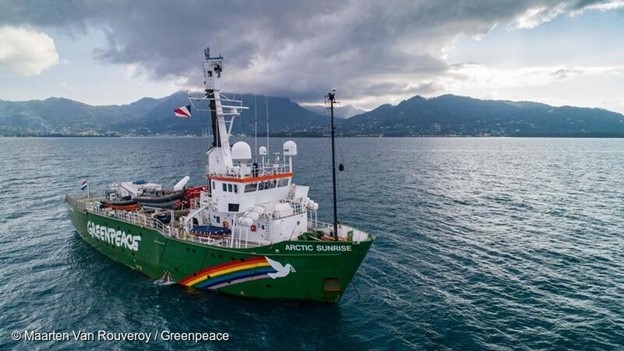Mapping whales at the Saya de Malha Bank
The Greenpeace ship Arctic Sunrise is currently at the Saya de Malha Bank to map and research the wildlife of the region with an international team of scientists. With the help of binoculars and hydrophones, they are looking for whales, dolphins, sharks, seabirds and turtles. You can follow the sightings on a live map online. The research expedition will continue until the end of March.
The team is also collecting water samples for environmental DNA monitoring. This novel method will help trace fish, sharks and whales by the DNA that is in skin cells, feces or scales that they leave behind. Mapping animals by their traces complements the visual and acoustic surveys by detecting species that are elusive, prefer the depths of the ocean, or are otherwise not easy to spot.
The Saya de Malha Bank is known for supporting the world’s largest seagrass meadow – and therefore one of the biggest carbon sinks in the ocean. The deep waters surrounding the bank are rich in nutrients, supporting sperm whales, flying fish and tuna. Governments around the world have recognized Saya de Malha as an Ecologically and Biologically Significant Area. The seabed is under joint management of Seychelles and Mauritius, while the water flowing through the seagrass meadows is international waters.
The team will also be capturing underwater footage of the seagrass growing on the bank. By keeping carbon safely locked in the seabed, seagrass meadows help slow down climate breakdown. Worldwide, they are critical feeding and breeding grounds to a wealth of wildlife from the easy-going dugong to sleek tiger sharks and a colourful assemblage of fish. So if the research team is very lucky, they might even see a dugong (even if the area might be a bit too exposed for a dugong’s taste, it is the world’s largest seagrass meadow after all!). Check the live blog for updates!
The research team on board is led by marine scientist Dr Kirsten Thompson. The sighting survey was designed in collaboration with marine megafauna specialists from the Harry Butler Institute at Murdoch University (Perth, Australia) and guided by insights of experts within the region, such as GLOBICE and the Indian Ocean Cetacean Research Network on whales and dolphins in the Mascarenes as well as the Seychelles Bird Records Committee on seabird observations.
New data and observations from the Saya de Malha Bank can hopefully contribute to understanding the diversity of life in the Western Indian Ocean and support designing effective conservation and management in the region. Communities across the Western Indian Ocean, from Seychelles to Mauritius, Réunion and Madagascar, are already showing the way in ocean protection. Greenpeace is calling on governments all around the world to agree a strong Global Ocean Treaty to help support people, protect wildlife and combat climate change. The Indian Ocean Voyage follows a year-long expedition across the Atlantic – from Pole to Pole – highlighting regions of unique biodiversity that are at risk from harmful human activities.
Contributors: Laura Meller
